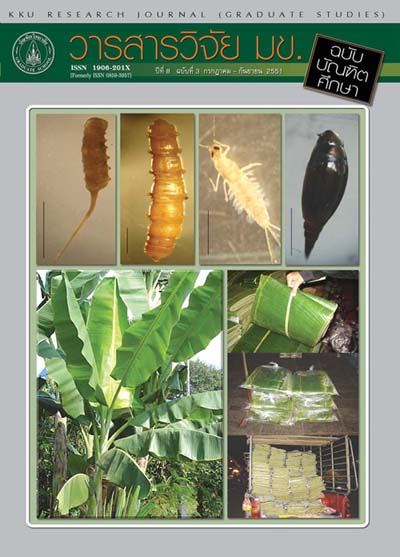Lactic Acid Production Using Sugar Cane Juice as a Substrate(การผลิตกรดแลกติกโดยใช้น้ำอ้อยเป็นสารตั้งต้น)
Keywords:
Lactic acid(กรดแลกติก), Lactic acid bacteria(แบคทีเรียกรดแลกติก), Sugar cane juice(น้ำอ้อย), Sucrose(น้ำตาลซูโครส)Abstract
To study lactic acid (LA) production from sucrose, five strains of lactic acid bacteria, namely Lactobacillus plantarum SP1-3, Lactobacillus pentosus KUB-ST 10-1, Lactobacillus casei TISTR 390, Lactobacillus salivarius ssp. salivarius TISTR 1112 and Lactobacillus delbrueckii ssp. bulgaricus TISTR 895 were investigated. Variation of 20-25 g l-1 carbon sources (glucose, sucrose and sugar cane juice) was carried out in flasks under static condition without controlled pH at 37 °C for 24 h. No significant differences were observed in LA production of all strains in the presence of glucose and sucrose. LA concentrations of 17-20 g l-1 were obtained from the cultivated cultures with glucose and sucrose except Lb. salivarius ssp. salivarius TISTR 1112 (11-12 g l-1). The ability of the strains to produce LA was decreased when using sugar cane juice and supplemented with 5 g l-1 yeast extract as a substrate. However, higher LA concentrations (15-23 g l-1) were noticed when the cultures were cultivated in a fermenter with controlled pH 6 at 37 °C and 150 rpm using 20-25 g l-1 sugar cane juice and supplemented with 5 g l-1 yeast extract. In addition, the cultivation time in the fermenter was shorter than that in the flask and higher productivity of LA was obtained.
งานวิจัยนี้ได้ศึกษาการผลิตกรดแลกติกโดยแบคทีเรียกรดแลกติก 5 สายพันธุ์ที่ใช้น้ำตาลซูโครสได้คือ Lactobacillus plantarum SP1-3, Lactobacillus pentosus KUB-ST 10-1, Lactobacillus casei TISTR 390, Lactobacillus salivarius ssp. salivarius TISTR 1112และLactobacillus delbrueckii ssp. bulgaricus TISTR 895 ซึ่งเพาะเลี้ยงเชื้อแบบไม่เขย่าในระดับฟลาสก์ เป็นเวลา24 ชั่วโมง ที่อุณหภูมิ37 ÌC และไม่ควบคุมค่า pH โดยการแปรผันแหล่งคาร์บอน(20-25 กรัมต่อลิตร)คือน้ำตาลกลูโคส น้ำตาลซูโครส และน้ำอ้อย ผลการทดลองพบว่าเมือใช้น้ำตาลกลูโคส และน้ำตาลซูโครสเป็นแหล่งคาร์บอน ผลผลิตกรดแลกติกไม่แตกต่างกัน ซึ่งLb. plantarum SP1-3, Lb. pentosus KUB-ST 10-1, Lb. casei TISTR 390 และ Lb. delbrueckii ssp. bulgaricus TISTR 895 สามารถผลิตกรดแลกติกได้ 17-20 กรัมต่อลิตรส่วน Lb. salivarius ssp. salivarius TISTR 1112 ผลิตกรดแลกติกได้เพียง 11-12 กรัมต่อลิตร เท่านั้น ส่วนการใช้น้ำอ้อยที่เติมยีส์สกัด 5 กรัมต่อลิตร เป็นสารตั้งต้นนั้น พบว่าเชื้อทั้ง5 สายพันธ์ ผลิตกรดแลกติกได้ลดลง แต่เมื่อนำแบคทีเรียกรดแลกติกทั้ง5 สายพันธ์นี้ มาเพาะเลี้ยงในถังปฏิกรณ์ชีวภาพโดยใช้น้ำอ้อย20-25 องศา ที่เติมยีสต์สกัด 5 กรัมต่อลิตรเป็นสารตั้งต้น ด้วยการควบคุมค่าพีเอช 6ที่อุณหภูมิ 37 องศาและมีอัตราการกวน 150 rpm พบว่าแบคทีเรียกรดแลกติกทั้งหมดที่นำมาศึกษาสามารถผลิตกรดแลกติกได้ในปริมาณที่สูงขึ้น(15-23 กรัมต่อลิตร)และใช้ระยะเวลาในการเพาะเลี้ยงสั้นกว่าการเพาะเลี้ยงในระดับฟลาสก์ จึงให้อัตราผลผลิตกรดแลกติกสูงกว่าอีกด้วย



